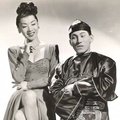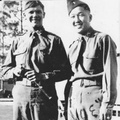Rehoboth, Mass. (Sept. 2, 2012)—Accounts of Japanese American participation in the military in World War II have understandably focused on the men and women of the 100th Battalion, the 442nd Regimental Combat Team and the Military Intelligence Service of the US Army.
Over 30,000 individuals served in these units from the beginning of the war through the occupation of Japan. Equally well documented are instances of men who attempted to enlist in the Army Air Corps, the Navy and the Marine Corps, but were rejected because of their Japanese ancestry.
Yet despite this racial barrier, some individuals did serve with distinction in the air and on the sea. The purpose of this brief notice is to remind us of their contribution to the war effort.

A 1944 photo of U.S. Navy Chief Machinist Mate Henry Matsumoto, left, and Lt. John Prentis on board Eagle 5, (Photo by Machinist Mate Robert Caso. (Photo from the Ronald Magden’s collections, courtesy of Japanese American Veterans Association)
The best-known Nisei in the Army Air Corps is surely Technical Sergeant (T/Sgt) Ben Kuroki, who flew 58 missions over both Germany with the 98th Bomb Group and Japan with the 505th Bomb Group. In a well-known biography, “Boy From Nebraska, The Story of Ben Kuroki” written by Ralph G. Martin, one can read his account of overcoming racial prejudice.
Others who served in air combat include Private First Class Minoru Arita of the 5th Air Force, T/Sgt. Herbert Ginoza of the 483rd Bomb Group, Staff Sergeant (S/Sgt) Michael Mitsuo Kamimoto and Henry Kojima of the 13th Air Force, T/Sgt Yukio Kishi, S/Sgt John Hideo Matsumoto, S/Sgt Kenje Ogata and S/Sgt. Joe Mitsuru Shiraishi. Lt. Noboru Tashiro was a weatherman for the Army Air Corps and one must not overlook Lieutenant Arata Kimura, who, though not in the Army Air Corps, spotted targets from his Piper Cub for the 522nd Field Artillery Battalion of the 442nd RCT.
The Japanese American Veterans Association is currently sponsoring a book on Japanese Americans in US military aviation.
A number of Nisei from the Army’s Military Intelligence Service were attached to Army Air Corps units and flew as voice intercept specialists on bombing missions, monitoring radio traffic and translating communications from the ground and hostile aircraft.
Flying members of the 1st Radio Squadron Mobile, included Yoshito Kawabe, George Okamoto and Kazuo Oshiki. Performing similar duty for the 8th Radio Squadron Mobile were Terry Adaniya, Mike Masao Deguchi, George Yoshiki Hanafusa, Yoshio Hoshide, Mamoru Ishii, Ted M. Ishisaka, Herbert M.U. Kawashima, Yoshio Kimoto, John Kozo Okada, Hiroshi Tanouye and James Shizuma Yoshioka.
Many other MISers were attached to Army Air Corps units and performed radio intelligence work from ground-based stations, but did not fly missions.
Far rarer are Japanese Americans in the Navy and Coast Guard. According to his obituary, James Ogura, Jr. of Evansville, IN, served in the Navy from 1942 to 1945 but no details about his experience are available.
Henry Matsumoto, Jr. was Chief Machinist Mate on the destroyer Eagle and had already been in the Navy 30 years when Pearl Harbor was attacked in 1941. When junior officers urged his removal from the ship, the captain refused to “beach the Eagle’s best machinist.” A photo from 1944 shows Chief Petty Officer Henry Matsumoto still on the deck of the Eagle.
Douglas T. Wada retired as a Navy Commander after 38 years of service in Naval Intelligence. His work in counter intelligence began before Pearl Harbor and at the end of hostilities he was assigned to the Prosecution Section of the International Tribunal for the Far East. In the Korean War era, he was with U.S. Naval Forces Far East, where he worked with intelligence sections of the Japanese government and defense establishment. Richard Takuichi Kanazawa and Roy M. Inouye are the only Japanese Americans known to the author to have served in the U.S. Coast Guard.
At least two Nisei served in the U. S. Marine Corps: Manuel Hiroshi “Curly” Hirata of Los Angeles and Max Tsuchida of Burlington, Wis. Sgt Hirata served with the Second Marine Division and participated in the battles of Guadalcanal and Tarawa. He was wounded at Tarawa and returned to the United States where he visited his family at Poston.
Sgt Hirata also fought in the Korean War and was awarded the Silver Star. The Pacific War found Nisei linguists of the Military Intelligence Service attached to Marine units in the major island campaigns.
More numerous are Japanese Americans in the Merchant Marine. Though not normally considered members of a uniformed military service, their duty on the high seas was hazardous enough.
According to one source, one in 26 merchant seamen died during the conflict. War Relocation Authority camp newspapers, obituary notices, and burial monuments have provided a list, undoubtedly incomplete, of World War II merchant mariners of Japanese ancestry: David K. Arata, Paul Seikichi Chinen, Noboru Harry Hashimoto, Paul S. Higa, Masami Jodoi, Richard Takuichi Kanazawa, Tsutomu Sam Kasai, Koichi Koizumi, Kenichi Mayeda, Al ‘Gunga’ Nakamura, Hideo Ogawa,. John Saito, Stanley Shouji Sakuda, ‘Palooka’ Shigehama, Toshio Shimabukuro, Chester Sumida, Martin Hisao Tanaka, Kiyoshi Tanita, and Takato Uyeno.
Thus, from a heterogeneous collection of sources, one learns that not every American serviceman of Japanese ancestry was destined for the infantry in the land Army during World War II. A relatively few did find ways around or through the racial barriers of the times to serve with the Army Air Forces, the Navy, the Coast Guard, the Marine Corps and the Merchant Marine.
*This article was originally published on Asian American Press on September 17, 2012.
© 2012 Asian American Press






